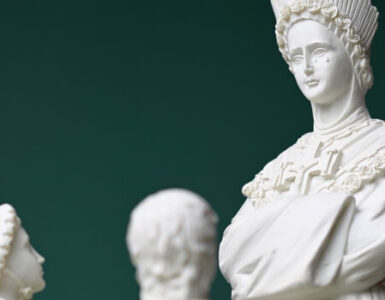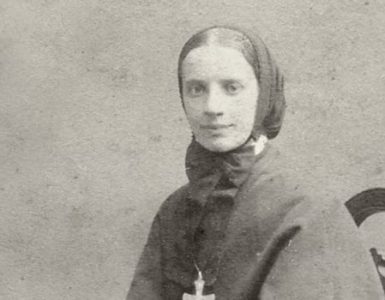One of the most renowned conversions in the history of the Church is that of Saint Ignatius of Loyola. Proud, vain, contentious, sensual, and worldly were all words that described the character of this pompous Spanish soldier until a cannon ball in the battle of Pamplona all but destroyed his legs.
After being transported back to his residence in Loyola, and after undergoing excruciating pains due to leg operations, Ignatius had days and weeks of free time in which the process of convalescence took its slow and painful course.
The advantage of literacy served to move him on the sure path to conversion. His preference was to read the novels of the day, so as to fill his mind with sensual images and romantic adventures. To his chagrin, none of this literary genre could be found in his domicile. Instead, two other forms of literature were brought to him: one on the life of Christ and another on the lives of the saints. At first Ignatius repelled these works. But given that he had so much free time and nothing much to do, he eventually decided to read them.
Soon thereafter, the Holy Spirit intervened and filled his mind and heart with an enormous desire to imitate the lives of these great heroes of God, the saints. Saint Ignatius exclaimed, “If Dominic could do it, then so can I; if Frances could do it, then so can I.” Reading and meditating upon the lives of the saints motivated Ignatius to leave his past life of sin and to follow Jesus, the True Commander and King.
Solid and profound spiritual books and classics can serve as powerful means to convert sinners and inspire readers to long for a life of true holiness. Let us delve into the world of spiritual classics and offer a list that we can immerse our minds into so as to be filled with spiritual treasures that can move us from spiritual anemia and mediocrity to a new life in the pursuit of heroic virtue and holiness. Our purpose will be to give a list of spiritual masterpieces (and a brief summary) from which to allow your reading and the Holy Spirit to do the work…
1. Confessions
Beyond a shadow of doubt, Augustine’s Confessions has gone down as one of the greatest literary masterpieces in the history of humanity. The biographical story of the “Doctor of Grace,” dictated in the most elegant language, describes the conversion of a man, once enslaved to sin and his passions, into a super-saint. Perhaps his most famous line from Confessions, Augustine writes, “O Lord, you have made our hearts for thee, and our hearts are restless until they rest in thee.”
2. The Rule of Saint Benedict
Saint Benedict, the founder of Western Monasticism, founded a Religious Order now known as the Order of Saint Benedict or “The Benedictines.” Inspired by the Holy Spirit, Benedict composed his “rules,” which have become the most famous Rules for the Religious Life. In it, Benedict outlines the different activities, virtues, and order that a monk should live by if he truly wants to pursue of life of authentic holiness. Benedict became the Father of Western monasticism, and his Rule has become the foundation and basis of Religious Life as a whole. His classic saying: “Ora et Labora”—pray and work!
3. Imitation of Christ
Emanating from the literary genre of the Rhineland mystics, the Imitation of Christ has become one of the most renowned spiritual classics in the 2000 years of Christianity. Authored by Thomas à Kempis, this classic insists upon attaining holiness through prayer, penance, mortification, humility, and detachment from the things of this world, so as to have one’s life attached most fully to Christ. It is divided classically into four books. The last of which is a masterpiece on the Mass, the Eucharist, and the love and reverence that we should have towards this greatest of sacraments. As Thomas à Kempis teaches, “it is not important a long life but a holy life.”
4. The Summa Theologica
Many consider Saint Thomas Aquinas to be the greatest of all saints in the history of the Church. In his 49 years of life, Thomas, the “Angelic Doctor,” was one of the most prolific writers in Christianity. His masterpiece was the Summa Theologica, considered the greatest summary and synthesis of theological ideas up to that time—the 13th century, the age of Scholasticism. Even to this day, the writings of Aquinas, and especially the Summa, are used as the foundation of theological training for seminarians and priests.
5. The Spiritual Exercises
As mentioned in our introduction, Saint Ignatius of Loyola underwent a radical conversion through spiritual reading. Afterwards, through the inspiration of the Blessed Virgin Mary in the cave of Manresa, this future saint composed the masterpiece that would change countless hearts—The Spiritual Exercises. The text has been proven to be an invaluable tool to help retreat groups encounter God, discover their purpose, learn the value of meditation, contemplation, and Confession, and to get to know, love, and follow Jesus Christ. Through perseverance, those who devote themselves to these exercises arrive at the heights of sanctity of life. Such is the fruit when one truly becomes a “contemplative in action” and is able to see and encounter God in all things, all person, and all places; God becomes all in all! Saint Ignatius writes, “Man is created to praise God, reverence God, serve God and by means of that save his soul” (Principle and Foundation #23).
6. The Interior Castle
The first woman to be declared a Doctor of the Church was Saint Teresa of Avila (followed by Saint Catherine of Siena). The Spanish Carmelite, mystic, and Doctor of the Church, Saint Teresa of Avila, is known as “The Doctor of Prayer.” Among her spiritual classics is The Interior Castle. In this masterpiece on prayer, Teresa presents a castle with different levels or rooms that indicate different levels of prayer: vocal prayer, mental prayer, prayer of affection, the prayer of simplicity, and mystical prayer. These forms of prayer culminate in the mystical marriage and union of the soul with Christ the Divine Bridegroom. For spiritual directors and those longing for a dynamic and deep union with God in prayer this classic is a “must!”
7. Catechism of the Council of Trent
The Catholic Church responded to the Protestant Reformation with the Counter-Reformation, during which the Holy Father convoked the Council of Trent. After various meetings, discussions, and even quarrels, the Council produced the first universal Catechism of the Catholic Church—the Catechism of the Council of Trent. Divided into four basic sections, the Catechism explains the teachings and doctrines of the Catholic Church with utmost clarity. The first section focuses on dogma, explaining the Creed; the second section on the sacraments as channels of grace; the third on morality, including an explanation of the ten Commandments; and the fourth on prayer—the life of union with God. Get to know your faith by reading this Catechism!
8. Introduction to the Devout Life
Saint Francis de Sales wrote a spiritual masterpiece for all who sincerely desire to learn the art of meditation and mental prayer. Using clear and concise language, Saint Francis offers a series of short chapters on timely spiritual topics to be meditated upon. It serves to enlighten our mind to the truths of the faith, but also to ignite our hearts with the fire of the love of God. The topics include: prayer, sin, death, judgment, Hell, Purgatory, the angels, the Mass and Holy Communion, Heaven, and many more. As a prayer primer it is essential!
9. The Glories of Mary
Written by Saint Alphonsus Liguori, another Doctor of the Church, The Glories of Mary would be considered by some as the greatest masterpiece ever written on the holiness, majesty, beauty, and power of the most Blessed Virgin Mary. Saint Alphonsus Liguori takes the Hail Holy Queen prayer, that we pray at the end of the Rosary, and explains it word for word, drawing from Sacred Scripture, the Fathers of the Church, scholars, and saints as his sources. To read this work is to fall in love with Mary and Jesus, the fruit of her womb.
10. The Bible
Perhaps this is the most obvious, but it should be expressed. By far the most important of all books is the Bible. The Bible should be first and foremost on our list of reading material because it is truly the Word of God. Saint Jerome stated sharply, “Ignorance of Sacred Scripture is ignorance of Christ.” May we delve into the infinite treasure and riches of God’s Word everyday!
In conclusion, it is our hope that all of us would have a real longing for holiness. May we utilize one of the most efficacious tools for growing in holiness by reading, meditating, and pondering on these spiritual classics.
Photo by Payton Tuttle on Unsplash













